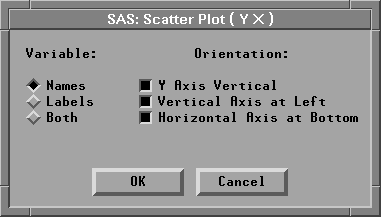Chapter Contents
Previous
Next
|
Chapter Contents |
Previous |
Next |
| Scatter Plots |

![[menu]](images/scaeq1.gif)
Figure 35.4: Scatter Plot Pop-up Menu
![[menu]](images/scaeq2.gif)
Related Reading | Scatter Plots, Chapter 5. |
Related Reading | Fitting Curves, Chapter 13. |
Related Reading | Confidence Ellipses, Chapter 18. |
|
Chapter Contents |
Previous |
Next |
Top |
Copyright © 1999 by SAS Institute Inc., Cary, NC, USA. All rights reserved.